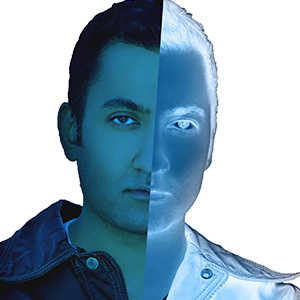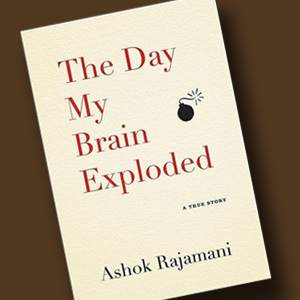Altered Reality

When Ashok Rajamani suffered a massive brain hemorrhage, just hours before his brother’s wedding, his life was transformed in an instant. How did he deal with this altered reality? Rajamani, who writes about it in his harrowing memoir, spoke to Khabar before he participated in Atlanta’s AJC Decatur Book Festival.
What happens to Ashok when a severe brain hemorrhage incapacitates him? He is first hospitalized in Washington, D.C., for three months. Later, overcoming two bouts of meningitis, tubes drilled into his skull to drain the brain of unwanted fluids, and several stressful and life-threatening situations at the hospital, he moves in with his parents to start the long and arduous path to rehabilitation. Rajamani soon discovers that he has lost half his vision in both eyes and that he would now be prone to episodes of epilepsy. Another downside from the hemorrhage is the loss of emotional memory and short-term memory. Loss of memory also brings with it some vagueness about his sexuality. The precise and often exhaustive description of the injury, consequent surgery, and recovery process allows the reader to truly grasp the severity of brain injury. A healthy dose of humor and wit softens the harshness of the gritty details: “An unseen nurse wheeled me into the operating room. It’s strange, but I swear it was my linebacker abuser Janet. Or was it Satan Mephistopheles himself? Let’s just call her Janestopheles.” Rajamani’s detailing of the many disappointing doctors’ visits and at times misleading medical advice is eye-opening and a worthy addition to current debates on the American health care system.
What the story lacks in narrative depth and language is made up for by the narrative arc, which goes back and forth between the past and the present, evoking the feverish hallucinations of his posttraumatic brain. By weaving certain stories from his childhood into the arc, the author renders a fuller and more vulnerable protagonist. Particularly interesting, for an Indian-American audience, are the accounts of racism and bullying that Rajamani encounters in school and his home-town community in Middle America. The description of holiday travel to India seems to be a common narrative conceit in current Indian-American writing. This book employs the same tactic, and unjustifiably so. In this instance, depictions of India seem prosaic and staid, and as such unnecessary and irrelevant to the story he is telling: “India was a world of contrasts…Farm animals stopped at crosswalks.” In contrast, though, his retelling of his early career experiences is refreshing and challenges the model-minority label that is often affixed to Indian experiences in the U.S.: “…public relations was a great place for an alcoholic, as the business not only welcomed drinking, it demanded it. I got the job and kept on boozing.” The book ends with Rajamani eventually making peace with his body, mind, and an altered reality. His writing is raw, visceral, and unabashed.
On your website, you describe yourself as a new
kind of Indian-American writer? Could you elaborate
on that?
By that I meant that I am a male Indian-American
writer…I couldn’t find any male Indian-American writers to begin with. Most writers are female. I was simply
trying to show that Indian-Americans don’t have to be
only in engineering, technology, or medicine. There are
other things we could do, too.
When did the idea for this book take shape?
Probably four years after rehab when I started attending brain injury support groups. I saw the horrible
things that could happen to people and the consequences they would have to bear [for the rest of their
lives]. Many of them were quadriplegic or paraplegic,
with tons of disabilities. I am very lucky. I am
blessed with the ability to articulate [my experiences].
I wanted to document my experiences.
Some of the stories you share are very intimate
and profound. How did you handle this with
your family?
Mine was a prototypical Indian family in an
all-white community. We were the odd-ballers.
Yes, in my family it was all about honor and dignity.
We kept everything to ourselves. So, I talked
to them about the book. They said, “Ashok, we
expect this from you!” They gave me the freedom
to be honest. This is not to say that I was
not wary. The book was my Christmas gift to
the family! I think my family has made their
peace with my writing now.

How does the publishing world treat
writers like you? Do they look for ethnic
stories or narratives?
That is an excellent question. I would
love to see more diversity in the South
Asian voice in American literature. There
seem to be very few Indian-American male writers.
I don’t think there is enough in contemporary
American literature about Indian and Indian-American
life experiences.
Do you have any advice for fledgling writers who
might want to write about intensely personal experiences,
especially those from our community?
You just have to throw away issues of fear. The
community might try to push you down. But you have
to be courageous and fearless.
Have readers walked up to you to talk about what
the book has meant to them?
Yes, I just had a reading in New Jersey, where my
parents live. Many of my parents’ friends are elderly
South Asians. One of them had recently gone through
prostate cancer. He attended my reading—and later
stood up and talked about it. He teared up. His wife told
me that he had never discussed these things with
her before. So…I really hope this book can help people
talk about mental health issues.
What books and writers do you turn to for inspiration?
I like acerbic memoirs…by writers like David
Sedaris or Augusten Burroughs. I love reading Kamala
Subramaniam’s translations of the Mahabharata. I
like Katherine Dunn’s Geek Love. I like reading books
that turn tragedy into hope with humor and
irreverence…the “anti-Oprah book club” books!
Where there’s no mawkishness…books that deal
with pain but are vulgar and funny.
I was surprised to read about your experience
with racism where you grew up.
Yes, racism was hard. I often say that if I hadn’t
survived racism and bullying, I would never have survived
this [hemorrhage]. Sometimes people don’t get
racism. Unless you grow up in a place like where I
grew up…in Illinois, where nobody looked like us…
you can never understand it. But I learned from those
experiences…the pain gave me strength.
I dedicated this book to the Indian boys and girls growing up in small-town America.
What has the reception been in
the South Asian community?
I am so delighted and awestruck
by how this book has been embraced
by the community. I was a bit trepidatious
at first. But I’ve had many Indians
and Indian-Americans writing to me about how they
loved the book. I feel like all ethnic writing [on
traumatic, life-changing experiences] is either black
or Hispanic [in the U.S.]. There isn’t enough out
there about what Indian-Americans go through.
There is also this model-minority label that we
have to aspire to….
Oh, absolutely.
In reading your book, I was struck by the level of
subjectivity in medical advice and quality of care that
you received. What kind of advice would you have for
survivors such as yourself and their families?
First, I would like to say that a patient’s recovery is
parallel to the doctor’s humanity. A lot of doctors have
this god-like image. Patients deserve more…more humanity
and kindness. I would advise people to do their
research. I for one went through many doctors. I have
had some great doctors, too. But patients should not
have to put up with abuse. No doctor is above you. So
keep searching until you find the right doctor and do
your own research.
Are you a full-time writer now?
Yes, I am a full-time writer now. I am currently
working on my next book titled If These Saris Could
Talk. It’s loosely based on the lives of women that we
know in India and the stories they tell and share.
Didn’t an earlier version of the title have something
to do with Curd Rice?
Yes! Adventures in Curd Rice! Oh, I could write tons
of stories about thayir sadam (Tamil for curd rice).
In one of the interviews that you did you said
that you see yourself as queer. I am curious to know
why you didn’t talk about it in greater detail in
your memoir.
Well, it’s like thayir sadam. Sexuality, like thayir
sadam, deserves its own book! But, absolutely, I
would definitely write about that. It just didn’t fit here,
though. This book was about my hemorrhage. Sexuality
deserves its own book.
Correction: Ashok Rajamani grew up in Illinois, not Michigan as originally written.
Enjoyed reading Khabar magazine? Subscribe to Khabar and get a full digital copy of this Indian-American community magazine.
blog comments powered by Disqus












